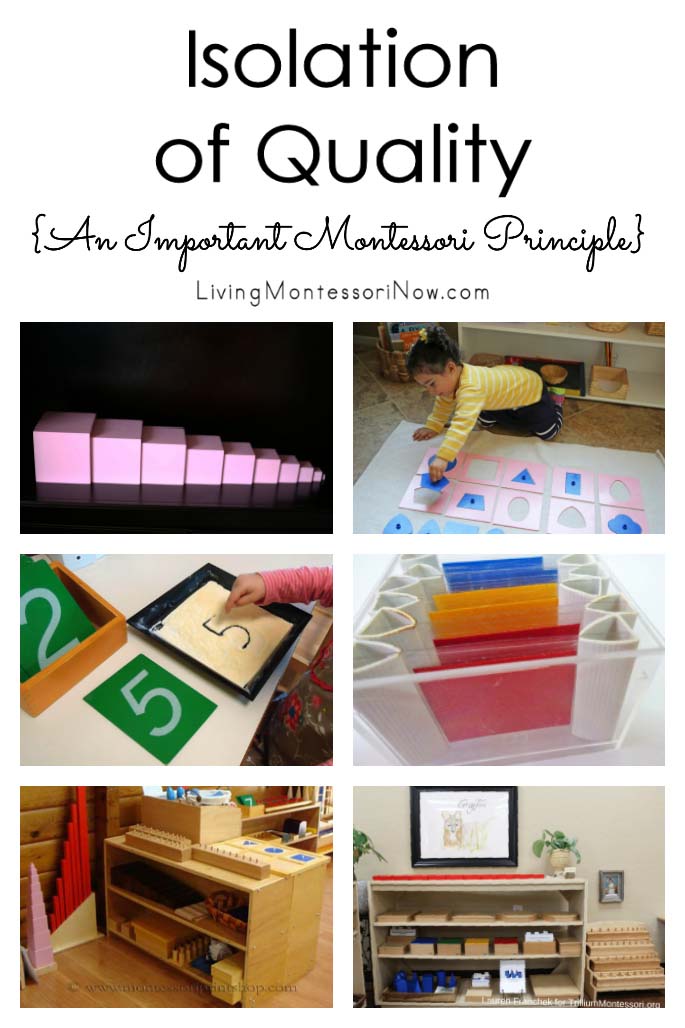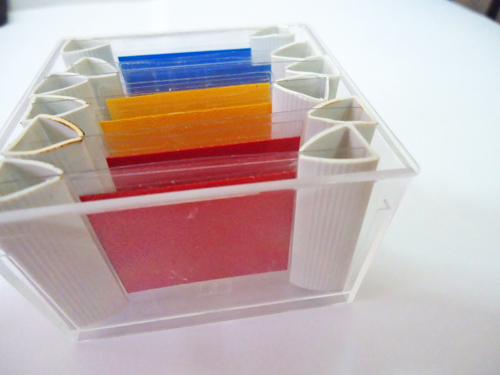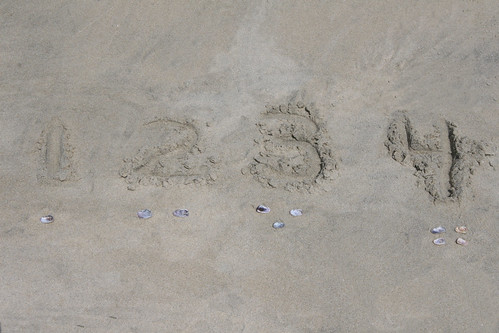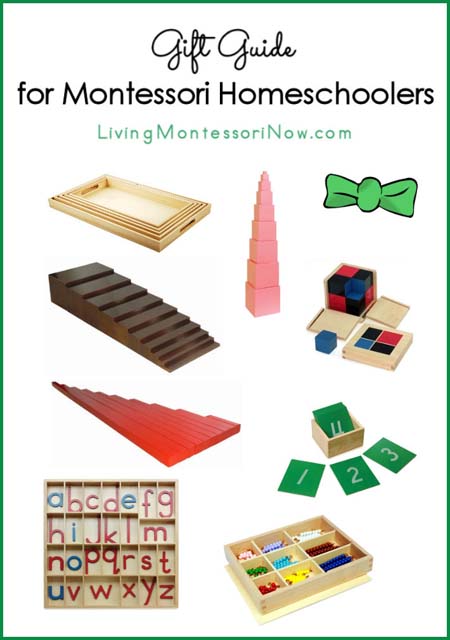Isolation of quality is a brilliant concept in Montessori education – a principle that can help you in both making and choosing materials. And isolation of quality is a concept you won’t find very often in preschool materials that aren’t Montessori-style materials.

You’ll especially notice isolation of quality in the Montessori sensorial materials – where each material isolates one specific quality, such as size, weight, shape, texture, color, sound, or smell.

Pink Tower
The pink tower in the photo varies only in size with all other qualities remaining constant. By eliminating elements that could be confusing or distracting, the child will focus on the quality being isolated.
The Montessori inset shapes only vary in shape, not color or size. That makes it so much easier for a young child to learn the names of the shapes. Thanks to isolation of quality, my granddaughter, Zoey, clearly understood what each Montessori inset shape was at age two. (Note: you can read my review of Alison’s Montessori plastic insets here.)

Montessori Sensorial Materials (Photo from Montessori Print Shop)
You’ll find more about Montessori sensorial materials in these posts: Montessori Sensorial Activities (my post with links to many of the Montessori sensorial articles and albums online) and Montessori Sensorial Overview – Scope and Sequence from Montessori Print Shop.

Sensorial Materials (Photo by Lauren Franchek for Trillium Montessori)
You’ll also find many examples of sensorial materials with isolation of quality in Lauren’s Montessori Sensorial Shelves at Trillium Montessori blog.

Sandpaper Numerals and Cornmeal Writing Tray (Photo from Dirigo Montessori School)
Isolation of quality makes it much easier for a child to learn a new concept in any area. For example, when the child is using sandpaper numerals to learn the number symbols, the numerals don’t vary in color or size. (Photo from Just Watching at Dirigo Montessori School)
Isolation of Quality in DIY Materials

DIY Color Tablets (Photo from Teacher Weena)
It’s very helpful if you can isolate the quality in DIY materials. Many homeschoolers, for example, make their own Montessori color tablets. You can follow the Montessori concept of isolating the quality by creating color tablets that vary in color only while keeping size and shape the same. (DIY Color Tablets – Photo from More Home/Teacher Made Manipulatives at Teacher Weena)
Similarly, the concept of number is clearest to the child in DIY numbers and counters in which the numerals vary only in numerical symbol and the counters vary only in quantity. You can do this with even the simplest version of cards and counters, such as outdoor numbers and counters using chalk-drawn numerals and objects such as pinecones or rocks or numbers and counters at the beach using numerals drawn in the sand and seashell counters.
There may be times when you create DIY materials where you don’t choose to isolate the quality, such as when you want to add interest by using a number of different colored eggs for an Easter activity or a number of different colored flowers for a spring activity. But with a child who’s just being introduced to a concept or a child who has difficulty with a concept, it’s especially helpful to remember to isolate one quality.
My gift guide for Montessori homeschoolers has resources for some of the essential Montessori materials with isolation of quality.
More on Montessori Principles
Top 10 Principles for Natural Learning gives an overview of some important Montessori principles to use at home. Become a More Successful Homeschooler by Using Montessori Principles tells about basic Montessori principles found in the materials. I also published a post on control of error, another Montessori principle that you’ll find especially helpful when creating your own materials.
I’d love to hear about your experiences with materials that had or didn’t have isolation of quality.
Learn more about my eBook Montessori at Home or School: How to. Teach Grace and Courtesy!
If this is your first time visiting Living Montessori Now, welcome! If you haven’t already, please join us on our Living Montessori Now Facebook page where you’ll find a Free Printable of the Day and lots of inspiration and ideas for parenting and teaching! And please follow me on Instagram, Pinterest (lots of Montessori-, holiday-, and theme-related boards), and YouTube. While you’re here, please check out the Living Montessori Now shop.
And don’t forget one of the best ways to follow me by signing up for my weekly newsletter. You’ll receive some awesome freebies in the process!










Hi Deb!…This post is so helpful. I wanted to aks you if you have a post about a transition of a 4 years old from a traditional preschool into a Montessori classroom. My daughter will start a Montessori school on next fall (thanks God!) but this year she started a traditional preschool classroom. I’ve been trying my best introducing her to the Montessori world but I don’t know which things she missed already. How can I help her to make the transition an easy one? Which activities I will have to make sure she has been introduced already? Sorry for such a long comment, I am kind of puzzle! Thanks so very much, as always for all your help.
Thanks for your comment, Airamty! I think the most important area to work on is practical life. Your daughter will find the easiest transition if she can work independently, can follow a series of steps in a lesson, and has the ability to concentrate. If you work on social graces in addition to her other practical life activities, she should fit in very well.
If you look at some of my Montessori curriculum areas (https://livingmontessorinow.com/2011/05/31/how-to-set-up-a-montessori-homeschool-classroom/), you can always add some of the basic sensorial, math, and language activities. But I know you already do a lot with your daughter. Good luck! I’m hoping your daughter will love her new school! 🙂
Thanks so much Deb! I am feeling better. So far she went twice to the Montessori school and keep asking me when are we coming back again because she loved it. I will check the link and thanks so much again!
My pleasure, Airamty! I’m so glad to hear your visits to the Montessori school have been great experiences! 🙂
That is SOOO interesting and something I’ve never given much thought. I used to teach struggling readers (first grade) and I would focus on only 1-2 things to fix at a time… letting everything else go. It worked pretty well but I never thought about my materials also being isolated like that. Very interesting.
Thanks so much for your comment, Jackie! It’s interesting that the concept isn’t seen much outside of Montessori education, but it really does make it easier for children to learn new ideas! 🙂
I always learn something new here! Montessori approaches are something I’m always leaning towards, but feel inadequate in implementing. Thanks for your posts that break it down for me. Think I”m going to start working on some DIY stuff this week. 🙂
Thanks so much, Kristi! I love DIY materials … I hope you have fun! 🙂
Wow Deb,
What wonderful resources, Thanks so much for sharing and also for hosting! Wishing you a wonderful week!
Many thanks, Mama of Many Blessings! Thanks for linking up … and I hope you have a wonderful week, too! 🙂
Deb, Excellent post! I love the true Montessori Materials. Saving up for some more currently. Do you have a recommended To Buy List?
Thanks for your kind comment, Kim! That’s a great question. I haven’t made up a list, since every homeschool is unique. If you look through my DIY posts, you’ll often see my recommendations for materials you can make rather than buy: https://livingmontessorinow.com/tag/diy-montessori-materials/.
Montessori Print Shop also has some helpful suggestions: http://www.montessoriprintshop.com/Use_Montessori_at_Home.html. And there are lots of suggestions in John Bowman’s Montessori at Home book. I hope that helps! 🙂